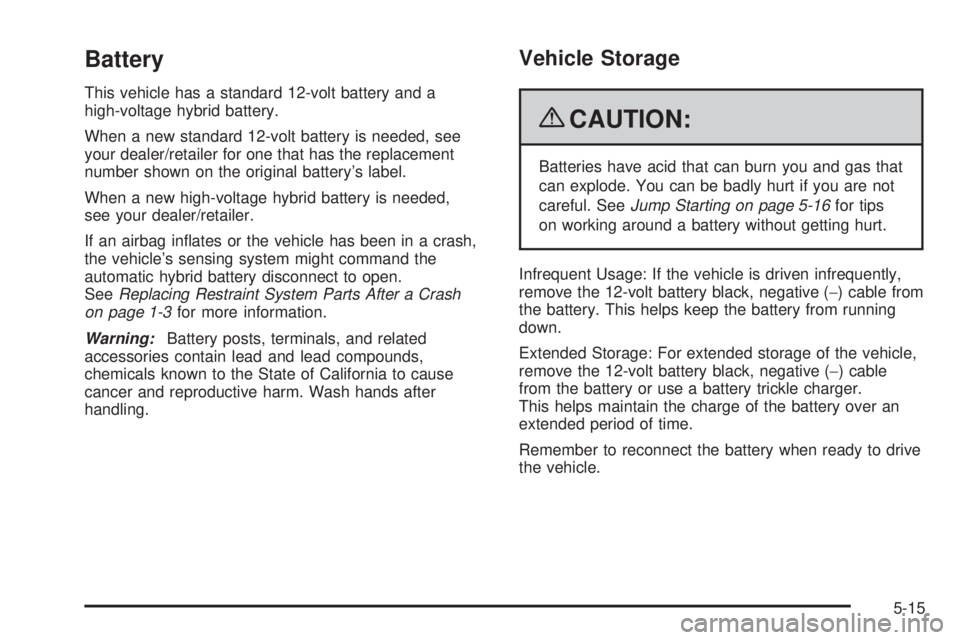Page 37 of 94

Service............................................................5-2
Doing Your Own Service Work.........................5-2
Checking Things Under the Hood.....................5-3
High Voltage Devices and Wiring......................5-3
Engine Compartment Overview.........................5-4
Automatic Transmission Fluid...........................5-5
Drive Motor/Generator Control Module (DMCM)
Coolant Surge Tank Pressure Cap..................5-6
Drive Motor/Generator Control Module (DMCM)
Cooling System...........................................5-6
Power Steering Fluid.....................................5-11
Brakes........................................................5-11
Battery........................................................5-15
Jump Starting...............................................5-16
Bulb Replacement..........................................5-21
Taillamps, Turn Signal, Stoplamps and
Back-up Lamps.........................................5-21
Replacement Bulbs.......................................5-22Electrical System............................................5-22
Fuses and Circuit Breakers............................5-22
Underhood Fuse Block..................................5-22
Tires..............................................................5-24
Inflation - Tire Pressure.................................5-24
Tire Pressure Monitor Operation.....................5-25
Tire Inspection and Rotation...........................5-29
Tire Chains..................................................5-30
If a Tire Goes Flat........................................5-30
Tire Sealant and Compressor Kit
(Without Selector Switch)............................5-32
Tire Sealant and Compressor Kit
(With Selector Switch)................................5-42
Tire Sealant and Compressor Kit Storage.........5-50
Capacities and Speci�cations..........................5-52
Section 5 Service and Appearance Care
5-1
Page 51 of 94

Battery
This vehicle has a standard 12-volt battery and a
high-voltage hybrid battery.
When a new standard 12-volt battery is needed, see
your dealer/retailer for one that has the replacement
number shown on the original battery’s label.
When a new high-voltage hybrid battery is needed,
see your dealer/retailer.
If an airbag inflates or the vehicle has been in a crash,
the vehicle’s sensing system might command the
automatic hybrid battery disconnect to open.
SeeReplacing Restraint System Parts After a Crash
on page 1-3for more information.
Warning:Battery posts, terminals, and related
accessories contain lead and lead compounds,
chemicals known to the State of California to cause
cancer and reproductive harm. Wash hands after
handling.
Vehicle Storage
{CAUTION:
Batteries have acid that can burn you and gas that
can explode. You can be badly hurt if you are not
careful. SeeJump Starting on page 5-16for tips
on working around a battery without getting hurt.
Infrequent Usage: If the vehicle is driven infrequently,
remove the 12-volt battery black, negative (−) cable from
the battery. This helps keep the battery from running
down.
Extended Storage: For extended storage of the vehicle,
remove the 12-volt battery black, negative (−) cable
from the battery or use a battery trickle charger.
This helps maintain the charge of the battery over an
extended period of time.
Remember to reconnect the battery when ready to drive
the vehicle.
5-15
Page 58 of 94

Replacement Bulbs
Exterior Lamp Bulb Number
Back-up Lamp and Rear Turn
Signal Lamp3156
Sidemarker Lamp 194
For replacement bulbs not listed here, contact your
dealer/retailer.
Electrical System
Fuses and Circuit Breakers
The wiring circuits in the vehicle are protected from
short circuits by a combination of fuses, circuit breakers
and fusible thermal links. This greatly reduces the
chance of fires caused by electrical problems.
Be sure you replace a bad fuse with a new one of the
identical size and rating.If you ever have a problem on the road and do not have
a spare fuse, you can borrow one that has the same
amperage. Just pick some feature of the vehicle that you
can get along without, like the radio or cigarette
lighter, and use its fuse, if it is the correct amperage.
Replace it as soon as you can.
The vehicle also has a special fuse in the battery box
for the 300-volt batteries. If this fuse has failed and
needs to be replaced, the vehicle will be disabled and
you will need to have the vehicle repaired by your
dealer/retailer. Do not attempt to self-service this fuse.
Underhood Fuse Block
Hybrid Auxiliary Underhood Fuse
Block
The hybrid underhood fuse block is located in the
engine compartment near the front of the vehicle.
Lift the cover for access to the fuse/relay block.
SeeEngine Compartment Overview on page 5-4for
more information on its location. For more information on
the main underhood fuse block, see “Underhood Fuse
Block” in the owner manual.
5-22
Page 91 of 94

A
Alternating Current
Power Outlet................................................ 2-2
Antilock Brake, System Warning Light.................. 3-7
Audio System(s)
Navigation/Radio System..............................3-14
Automatic Transmission, Fluid............................ 5-5
B
Battery..........................................................5-15
Brake Fluid....................................................5-11
Brakes..........................................................5-11
Regenerative Braking...................................2-10
System Warning Light.................................... 3-6
Bulb Replacement
Taillamps, Turn Signal, Stoplamps and
Back-up Lamps........................................5-21
C
Canadian Owners................................................ ii
Capacities and Specifications............................5-52
Chains, Tire...................................................5-30
Charging System Light...................................... 3-4Climate Controls............................................... 3-2
Compressor Kit
Storing.......................................................5-50
Compressor Kit, Tire Sealant....................5-32, 5-42
Coolant
Engine Temperature Gage.............................. 3-8
Coolant Surge Tank Pressure Cap, (DMCM)......... 5-6
Cooling System, (DMCM).................................. 5-6
D
Drive Motor/Generator Control Module (DMCM)
Coolant Surge Tank Pressure Cap................... 5-6
Drive Motor/Generator Control Module (DMCM)
Cooling System............................................. 5-6
Driver Information Center (DIC).........................3-12
Warnings and Messages...............................3-12
E
Engine
Compartment Overview.................................. 5-4
Coolant Temperature Gage............................. 3-8
Drive Belt Routing......................................... 6-2
1